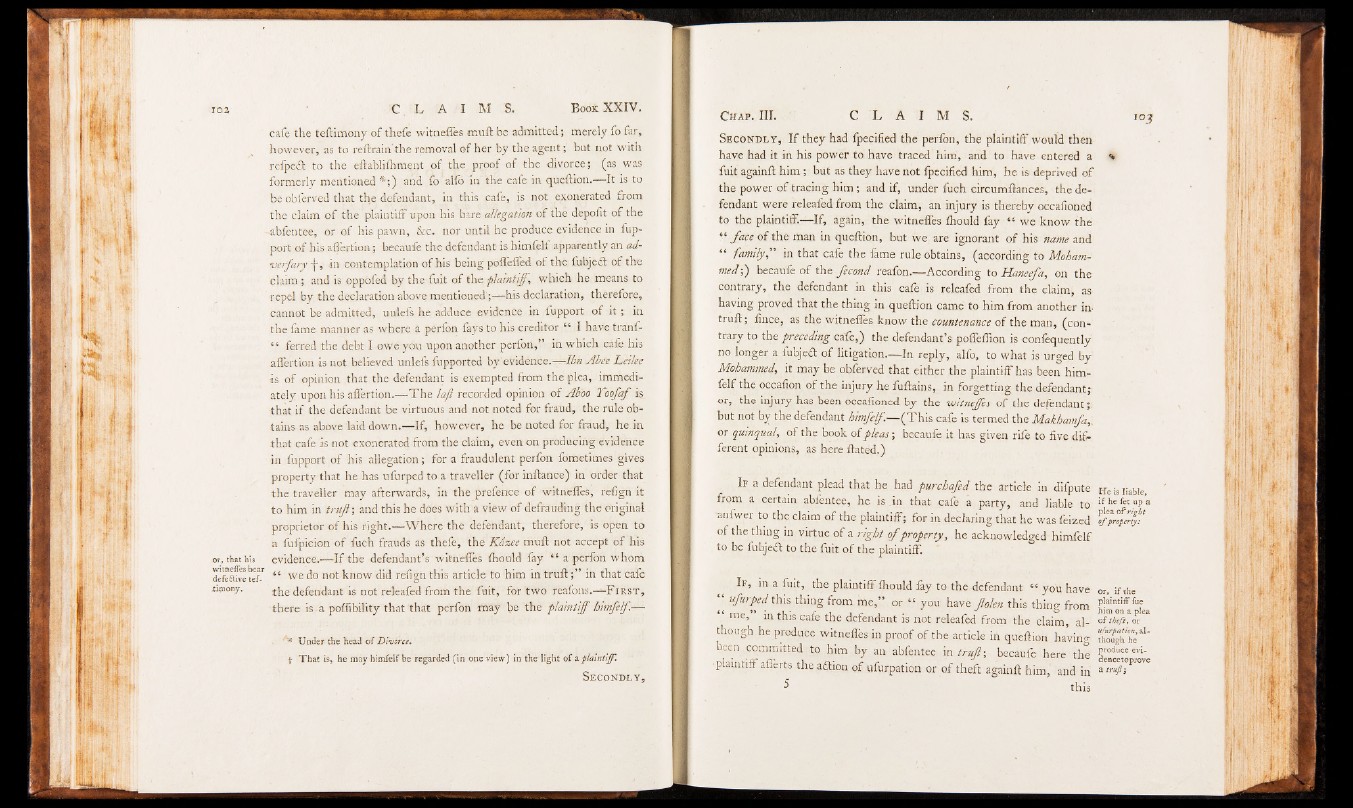
103 C L A I MS S. B o o k XXIV.
or, that his
witneffes bear
defeftive tef-
.timony.
cafe the teftimony of thefe witneffes ffiuft be admitted; merely fo far,
however, as to reftrain the removal ©f her by the agentbut not with
refpedt to the eftablifiiment of the proof of the divorce; (as was
formerly mentioned * ;) and fo alfo in the cafe in queftion.— It is to
be obferved that the defendant, in this cafe, is not exonerated from
the claim .of the plaintiff upon his bare allegation of the depofit o f the
-abfentee, or of his pawn, &c. nor until he produce evidence in fup-
port of his afiertion; becaufe the defendant is himfelf apparently an ad-
iverfary -j-, in contemplation o f his being poffeffed of the fubjeft of the
claim ; and is oppofed by the fuit of the ■ plaintiff, which he means to
■ repel by the declaration above mentioned';— his declaration, therefore,
cannot be admitted, unlefs he adduce evidence in fupport of i t ; in
the fame manner as where a perfon fays to his creditor “ I have tranf-
“ ferred the debt I owe you upon another perfon,” in which cafe his
affertion is not believed unlefs fupported by' evidence.— i f c Alee Leilee
is of opinion that the defendant is exempted from the plea, immediately
upon his afTertion.— T h e laß recorded opinion of Ab'oo Toofaf is.
that if the defendant be virtuous and not noted for fraud, the rule obtains
as above'laid down.— If, however, he be noted for fraud, he in
that cafe is not exonerated from the claim, even on producing evidence
in fupport of his allegation; for a fraudulent perfon fometimes gives
property that he has ufurped to a traveller (for inftance) in order that
the traveller may afterwards, in the prefence of witneffes, refign it
to him in tru fl; and this he does with a view of defrauding the original
proprietor of his right.— Where the defendant, therefore, is open to
a fufpicion of fuch frauds as thefe, the Kazee muff not accept of his
evidence.— I f the defendant’ s witnefles fhould fay “ a perfon whom
“ we do not know did refign this article to him in t r u f t i n that cafe
the defendant is not releafed from the fuit, for two reäfons.— F i r s t ,
there is a poffibility that that perfon may be the plaintiff himfelf.—
‘‘ t* Under the head o f Divorce,
f T h a t is, he may himfelf be regarded (in one view) in the light o f a plaintiff'.
S e c o n d l y ,
S e c o n d l y , I f they had fpecified the perfon, the plaintiff would then
have had it in his power to. have traced him, and to have entered a
fuit againft him; but as they have not fpecified him, he is deprived of
the power of tracing him; and if, under fuch circumftances, the defendant
were releafed from the claim, an injury is thereby occafioned
to the plaintiff,— If, again, the witneffes fhould fay “ we know the
‘■ '■ face of the man in queftion, but we are ignorant of his name and
“ family,” in that cafe the fame rule obtains, (according to Mohammed
f) becaufe of the fecond reafon.— According to Haneefa, on the
contrary, the defendant in this cafe is releafed from the claim, as
having proved that the thing in queftion came to him from another in.
truft ; fince? as the witnefles know the countenance of the man, (contrary
to the, preceding cafe,) the defendant’s pofleflion is confequently
no longer a fubject of litigation.— In reply, alfo, to what is urged by
Mohammed, it may be obferved that either the plaintiff has been himfelf
the occafion of the injury he fuftains, in forgetting the defendant;
or, the injury has been occafioned by the witneffes of the defendant;;
but not by the defendant himfelf— (This cafe is termed the Makhamfa,..
or quinqual, of the book of pleas-, becaufe it has given rife to five different
opinions, as here ftated.)
I f a defendant plead that he had pur chafed the article in difpute
from a certain abfentee, he is in that cafe a party, and liable to
'anfwer to the claim of the plaintiff; for in declaring that he was feized
of the thing in virtue of a right o f property, he acknowledged himfelf
to be fubjedt to the fuit of the plaintiff '
I f , in a fuit, the plaintiff fhould fay to the defendant “ you have
“ ufurped this thing from me,” , or “ you have ftalen this thing from
“ me, in this cafe the defendant is not releafed from the claim, although
he produce witneflesjn proof o f the article in queftion having
been committed to him by an abfentee in truft-, becaufe here the
■ plaintiff aflerts the aftion of ufurpation or of theft againft him, and in
5 this
He is liable,
i f he fet up a
plea o f right
ofproperty:
or, i f the
plaintiff fue
him on a plea
o f theft, or
ufurpation, although
he
produce evi-
dencetoprove
a truft j